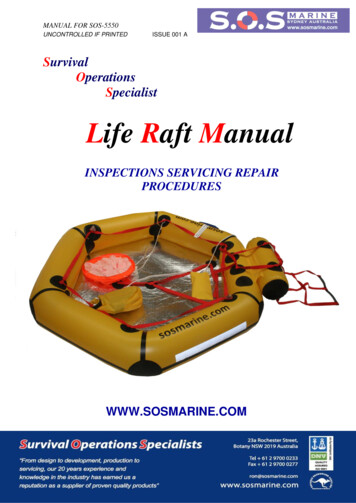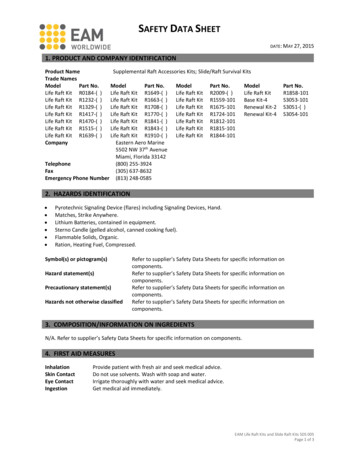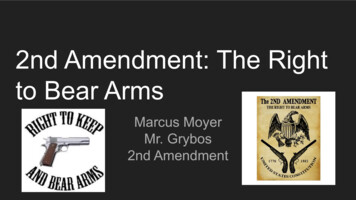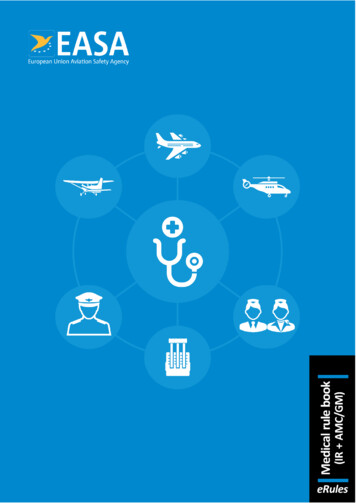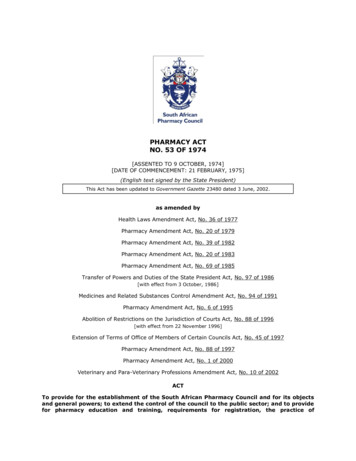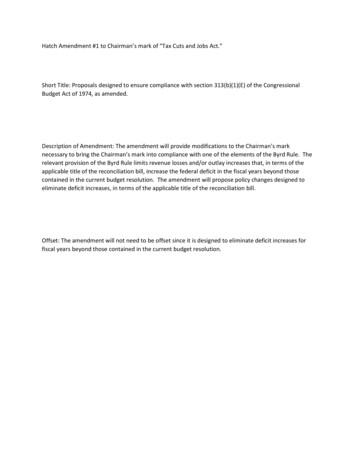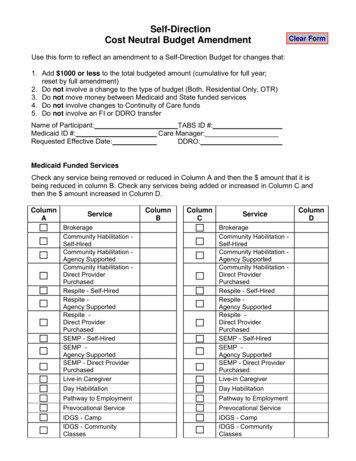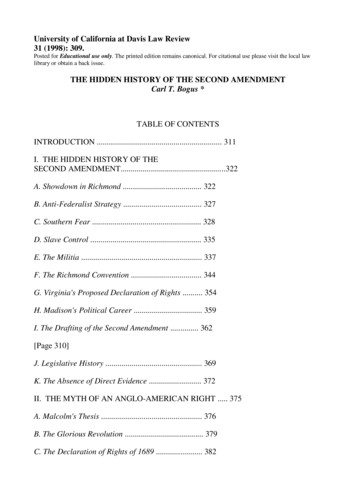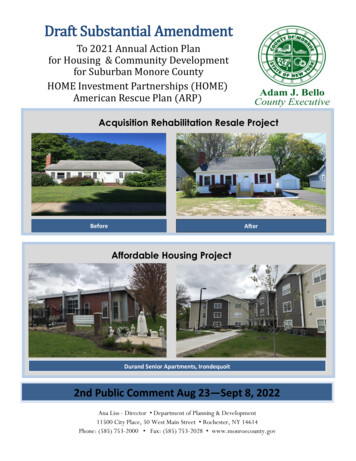
Transcription
Draft Substantial AmendmentTo 2021 Annual Action Planfor Housing & Community Developmentfor Suburban Monore CountyHOME Investment Partnerships (HOME)American Rescue Plan (ARP)Acquisition Rehabilitation Resale ProjectBeforeAfterAffordable Housing ProjectDurand Senior Apartments, Irondequoit2nd Public Comment Aug 23—Sept 8, 2022Ana Liss - Director Department of Planning & Development11500 City Place, 50 West Main Street Rochester, NY 14614Phone: (585) 753-2000 Fax: (585) 753-2028 www.monroecounty.gov
HOME-ARP Allocation Plan Template with GuidanceInstructions: All guidance in this template, including questions and tables, reflectrequirements for the HOME-ARP allocation plan, as described in Notice CPD-21-10:Requirements of the Use of Funds in the HOME-American Rescue Plan Program, unless notedas optional. As the requirements highlighted in this template are not exhaustive, please refer tothe Notice for a full description of the allocation plan requirements as well as instructions forsubmitting the plan, the SF-424, SF-424B, SF-424D, and the certifications.References to “the ARP” mean the HOME-ARP statute at section 3205 of the American RescuePlan Act of 2021 (P.L. 117-2).ConsultationIn accordance with Section V.A of the Notice (page 13), before developing its HOME-ARPallocation plan, at a minimum, a PJ must consult with: CoC(s) serving the jurisdiction’s geographic area, homeless service providers, domestic violence service providers, veterans’ groups, public housing agencies (PHAs), public agencies that address the needs of the qualifying populations, and public or private organizations that address fair housing, civil rights, and the needs ofpersons with disabilities.State PJs are not required to consult with every PHA or CoC within the state’s boundaries;however, local PJs must consult with all PHAs (including statewide or regional PHAs) and CoCsserving the jurisdiction.1
Participating Jurisdiction: Monroe County, New YorkDate: 9/9/2022Describe the consultation process including methods used and dates of consultation:Monroe County, in partnership with the City of Rochester and the Continuum of Care, locally knownas Partners Ending Homelessness (the “CoC”), developed two key components for its consultationprocess, both of which involve collecting feedback from community members. The first componentwas to design and disseminate a survey to help identify gaps and unmet needs in housing and servicedelivery systems and prioritize eligible activities including the development and support of affordablerental housing, tenant-based rental assistance, supportive services, acquisition and development of noncongregate shelters, and non-profit operating and capacity building assistance. The on-line survey waswidely distributed electronically through a variety of community outlets, at the Homeless ServicesNetwork (HSN), which is a conglomerate comprised of over 80 community-care and human servicesproviders, including those that serve the homeless, domestic violence victims, veterans, and personswith disabilities. The HSN also includes public housing agencies that address the needs of fair housingand enforcement of civil rights. The survey was available from December 2021-March 2022. It wasalso shared via the CoC’s weekly newspaper that is distributed to over 400 community membersthroughout Monroe County. Recipients were also asked to share the surveys with those within theirnetwork in order to reach additional stakeholders. 84 individuals responded to the survey.In addition, in December 2021, Monroe County and its partners announced the anticipated fundingwith a presentation to the Homeless Services Network monthly stakeholders meeting. The presentationidentified the qualifying populations and the five qualifying activities, the total available resources forthe County and City, as well as next steps, prior to the submission of the County and City’s respectiveAllocation Plan to HUD. The second component in the consultation process continued with severalvirtual meetings with key stakeholders serving Monroe County and the City of Rochester. Virtualmeetings with public housing authorities, affordable housing developers, religious leaders, funders,and service providers who serve the qualifying populations eligible through the HUD HOME-ARPutilized the Discussion Guide for HOME-ARP Consultation Meetings provided by HUD and helpedto further identify gaps and needs in the community that the data did not fully address. The consultationmeetings were held between January, February, and March of 2022. The feedback received issummarized in the chart below. Final funding decisions for projects and programs receiving HOMEARP funds will be determined through a Request for Proposals (RFP) or a Request for Qualifications(RFQ), as appropriate. The RFP or RFQ process will be in coordination with the City of Rochester,the CoC with input from the Monroe County Department of Human Services.List the organizations consulted:Agency/OrgConsultedRochester HousingAuthority (RHA)Type ofAgency/OrgPublic HousingAuthorityMethod ofConsultationVirtual 1/24/222FeedbackCase Management, Short-termemergency Housing, and more time forhousing searches are all needed. Morefamily/elderly housing is needed
CoC/Partners EndingHomelessness (PEH)Local CoC/ServicePlan consultantagency/homelessness/ partner/coHMIShost/VirtualFairport Urban Renewal HousingAgency (FURA)Virtual 1/24/22Rochester AreaCommunity Foundation(RACF)Funder/Serves AllVirtual 2/15/22Qualifying populationsHousingCouncil/PathStoneFair Housing/Civil Rights Virtual 2/15/22Case management/services key tosuccess for qualifying populations.Difficult to find appropriate,affordable housing – need supportservices to remain stably housedCase Management, Short-termemergency Housing, and more time forhousing searches are all needed. Morefamily/elderly housing is neededContinuity of systems. Renters arepaying more for rent than they canafford. Are community resourcesadequate?Streamline shared databases. Therehave been discrimination complaintsrelated to housing quality. There is alack of trust in sharing documentationamongst peopleVirtual 2/15/22Rochester Monroe Anti- MultiplePoverty InitiativeHousing/Jobs/serving(RMAPI)qualifying populationsLack of safe, affordable housing forqualifying populations. Manyhabitability and code issues.Qualifying populations face barriersto housing opportunitiesYWCADomestic Violence/HomelessnessVirtual 2/15/22Housing for people with disabilities,Mental Health and fleeing disabilitiesEmpire JusticeHomelessness/FairHousing/Civil RightsVirtual 2/15/22Supportive Services should matchappropriate housing levels per ESLRental Housing StudyLegal Aid of Western NY Fair Housing/CivilRightsVirtual 2/15/22JustCauseFair Housing/CivilRights/Virtual 2/15/22Regional Center forIndependent LivingVirtual 2/15/22Service Agency ack of safe, affordable housing forqualifying populations. Manyhabitability and code issues.Qualifying populations face barriersto housing opportunitiesLack of safe, affordable housing forqualifying populations. Manyhabitability and code issues.Qualifying populations face barriersto housing opportunitiesLack of safe, affordable housing forqualifying populations. Manyhabitability and code issues.Qualifying populations face barriersto housing opportunitiesSpiritus Christi PrisonOutreachPersons exitingprison/OtherVirtual 3/4/223Landlords less likely to rent to thosewith bad credit/rent history. Qualifying
populations/Homelessnesspopulations have greater barriers tosecuring housing than typicalhouseholds because of the lack ofdocumentationNeed help in securing documentation,searches, and continued casemanagement. Limited supply ofadequate affordable housingEagle StarVeterans/Homelessness Virtual 3/4/22Veterans OutreachCenter (VOC)Veterans/Homelessness Virtual 3/4/22Qualifying populations face greaterbarriers to finding/securing housing.Need case management, securingdocumentation. Limited availableadequate and affordable housingWillow CenterDomestic ViolenceRent Subsidies and wrap-aroundservicesCoordinated CareServices, Inc. (CCSI)Service agency-serves Virtual 3/4/22qualifyingpopulation/homelessness, coordinated entryHuther DoyleService agency-serves Virtual 3/4/22qualifying population,homelessness,addiction and mentalhealthPersons exiting prison, Virtual 3/4/22homelessnessReentry Association ofWNYVirtual 3/4/22Needs assistance w/documentationand housing search/placement,continued case management.Landlords less likely to rent to thosew/credit/rent history issues. Limitedsupply of adequate and affordablehousingQualifying population face greaterbarriers to finding/securing housing.Needs assistance w/securing neededdocumentation. Continued casemanagement.Qualifying population face greaterbarriers to finding/securing housing.Needs assistance w/securing neededdocumentation. Continued casemanagement.Summarize feedback received and results of upfront consultation with these entities:4
Public ParticipationIn accordance with Section V.B of the Notice (page 13), PJs must provide for and encouragecitizen participation in the development of the HOME-ARP allocation plan. Before submissionof the plan, PJs must provide residents with reasonable notice and an opportunity to comment onthe proposed HOME-ARP allocation plan of no less than 15 calendar days. The PJ mustfollow its adopted requirements for “reasonable notice and an opportunity to comment” for planamendments in its current citizen participation plan. In addition, PJs must hold at least onepublic hearing during the development of the HOME-ARP allocation plan and prior tosubmission.PJs are required to make the following information available to the public: The amount of HOME-ARP the PJ will receive, and The range of activities the PJ may undertake.Throughout the HOME-ARP allocation plan public participation process, the PJ must follow itsapplicable fair housing and civil rights requirements and procedures for effectivecommunication, accessibility, and reasonable accommodation for persons with disabilities andproviding meaningful access to participation by limited English proficient (LEP) residents thatare in its current citizen participation plan as required by 24 CFR 91.105 and 91.115.Describe the public participation process, including information about and the dates of thepublic comment period and public hearing(s) held during the development of the plan: Date(s) of public notice: April 22, 2022 and August 23, 2022 Public comment period: May 5, 2022 end date – June 13 and August 23, 2022 end date - September 8, 2022. Date(s) of public hearing: May 5, 2022 Describe the public participation process:Community input and engagement has been the driving force in the development of MonroeCounty’s HOME-ARP Allocation Plan. We facilitated a hybrid in-person and virtual publichearing, which was held on May 5, 2022 at 10:00a.m., with a public comment period fromMay 5-June 13, 2022. Notice of the public hearing was posted with the Daily Record, theRochester Business Journal, and on the Monroe County website, with a proposed fundingbreakdown of the County’s HOME-ARP Allocation Plan distribution for all eligible activities.The County delivered a PowerPoint presentation outlining all eligible activities andsummarized the process of how the proposed funding was determined. The HOME-ARPAllocation Plan will be submitted as part of a Substantial Amendment to the 2021-22 AnnualAction Plan at the end of the public comment period and upon Legislature approval of thePlan, which incorporates information gleaned from public surveys, data collected throughconsultations, and recommendations received during the consultation process and publiccomment period.5
A second public notice was posted with the Daily Record, the Rochester Business Journal,and on the Monroe County website for an additional 15-day public comment period,beginning August 23 to September 8, 2022, which included additional gap analysis and needsassessment and updated information to reflect the 2022 Point-In-Time (PIT) and HousingInventory Count (HIC). All comments received will be included.Describe efforts to broaden public participation:Notice of the public hearing was posted in the local newspapers, including the Daily Recordand the Rochester Business Journal in addition to the Community Development page of theMonroe County website. The public notice was mailed to all of the municipal memberswithin the County consortium as well as service providers within the County’s network forfurther input. The public comment period was open for 37 days to allow for more time tosolicit public comments. Monroe County posted a 2nd public notice for an additional 15-daycomment period from August 23-September 8, 2022.Summarize the comments and recommendations received through the public participationprocess either in writing, or orally at a public hearing:Monroe County received one submitted public comment/inquiry during the publicparticipation process, which was from a developer looking to develop family housing in thesuburban market at 50-60% of the Area Median Income (AMI). The proposal does not fit theHOME-ARP rubric, and we therefore spoke to this developer about possible alternativefunding streams, which were more consistent with the County’s regular year entitlementfunding (see next question for more detail).Summarize any comments or recommendations not accepted and state the reasons why:As stated above, we received a public comment from a developer regarding a potentialhousing development for families in the town of Henrietta. This request did not fit underthe HOME-ARP umbrella because it did not serve the eligible qualifying populations listedunder HOME-ARP and suggested the developer submit a proposal utilizing the County’sreallocated 2019 HOME Entitlement funds as a potential alternative funding source, or theCounty’s regular year entitlement funding. The developer had seen a different public noticeon the Community Development page of the Monroe County website for a reallocation ofthe County’s 2019 HOME Entitlement funds.All comments received during the public hearing and public comment period are accepted.6
Needs Assessment and Gaps AnalysisIn accordance with Section V.C.1 of the Notice (page 14), a PJ must evaluate the size anddemographic composition of all four of the qualifying populations within its boundaries andassess the unmet needs of each of those populations. If the PJ does not evaluate the needs of oneof the qualifying populations, then the PJ has not completed their Needs Assessment and GapsAnalysis. In addition, a PJ must identify any gaps within its current shelter and housinginventory as well as the service delivery system. A PJ should use current data, including point intime count, housing inventory count, or other data available through CoCs, and consultationswith service providers to quantify the individuals and families in the qualifying populations andtheir need for additional housing, shelter, or services.Monroe County Homeless Needs Inventory and Gap Analysis TableHomelessCurrent PermanentSupportiveHousingOther ssAdults OnlyVets# ofBeds# ofUnits#ofBeds# ofUnits# 7370Homeless PopulationFamily AdultHH (atHHVictimsVetsleast 1of DV(w/ochild) child)65492689004212Gap AnalysisFamily# ofBeds# ofUnitsCurrent GapData Sources: 1. Point in Time Count (PIT); 2. Continuum of Care Housing Inventory Count (HIC); 3. ConsultationMonroe County Housing Needs Inventory and Gap Analysis TableNon-HomelessTotal Rental UnitsRental Units Affordable to HH at 30%AMI (At-Risk of Homelessness)Rental Units Affordable to HH at 50%AMI (Other Populations)Current Inventory# of Units55,76712,66212,8757Level of Need# of HouseholdsGap Analysis# of HouseholdsAdults Only# ofBeds#ofUnits
0%-30% AMI Renter HH w/ 1 or moresevere housing problems(At-Risk of Homelessness)30%-50% AMI Renter HH w/ 1 or moresevere housing problems(Other Populations)7,6657,605Current GapsData Sources: 1. 2020 American Community Survey (ACS); 2. 2018 Comprehensive Housing AffordabilityStrategy (CHAS)8
Describe the size and demographic composition of qualifying populations within the PJ’sboundaries:Homeless as defined in 24 CFR 91.5As of the draft of the Allocation Plan, the most recent one day data inRochester/Monroe County was from January, 2021. There were 358 persons in theemergency shelter system and 33 unsheltered persons found (additional data isincluded in the above referenced table.) As of the same time in 2022, there were 588persons in the emergency shelter system and 42 persons were unsheltered. During thissame period, there were 82 adult survivors of domestic violence. The difference in thedata from the two years prompted Monroe County to post for a second 5-day publiccomment period. The Point-In-Time (PIT) survey is conducted by the CoC annuallyduring the last week in January and is valuable data in determining and analyzing thesize and demographic composition of the qualifying populations within MonroeCounty’s service area for this Plan. The County utilized PIT, HIC, and ACS data, as well asdata gathered from the on-line survey and consultation meetings in preparing theCounty’s Allocation Plan.At Risk of Homelessness as defined in 24 CFR 91.5Per the 2018 CHAS data for Monroe County, 8% of all households have an income under 30% ofthe HAMFI, and nearly 10% of the renter population in Monroe County moved into their housingin 2019 or later, according to the 2020 American Community Survey (ACS). Additionally, 506 (or0.5%) of renters occupied housing units had an occupancy rate of 1.51 or more persons perroom per the 2020 ACS. These statistics indicate that there exists a population at risk ofhomelessness as defined in 24 CFR 91.5.Fleeing, or Attempting to Flee, Domestic Violence, Dating Violence, Sexual Assault,Stalking, or Human Trafficking, as defined by HUD in the NoticeAs of the 2022 PIT, there were 82 Adult survivors of Domestic Violence in EmergencyShelters and 9 in Transitional Housing. Two were unsheltered. Compared to the 2021PIT, there were 76 in Emergency Shelters and 7 in Transitional Housing with 4unsheltered.Other populations requiring services or housing assistance to prevent homelessness andother populations at greatest risk of housing instability, as defined by HUD in the NoticeThe average age of residents of Monroe County is going up, with over 30% of the totalpopulation being over the age of 55. Older members of the community need safe,affordable, and accessible housing options in order to avoid housing instability. MonroeCounty continues to provide programs aimed at preventing homelessness in thecommunity, including rental assistance and legal assistance for persons facing eviction.Over the last two years, Monroe County and its partners have worked on severalprograms aimed at preventing homelessness in the community, including rentalassistance and legal assistance to persons facing eviction. It is difficult to determine the9
size of this population or if it has risen due to the pandemic. Data within the suburbantowns and villages have been more difficult to obtain due to the individual town andvillage courts handling their own cases since the eviction moratorium ended and eachrespective town is handling their own cases.Identify and consider the current resources available to assist qualifying populations,including congregate and non-congregate shelter units, supportive services, TBRA, andaffordable and permanent supportive rental housing (Optional):Funding available in the Monroe County service area the last two years have been throughTreasury, which included CARES Act and Emergency Rent Assistance Program (ERAP),including the County’s HUD Entitlement funds. Although majority of these funds have beenmostly spent, current resources include annual HUD funding for the County (City and CoC)and other leveraged funding for the development of affordable rental housing andsupportive services, housing, housing choice vouchers, as well as local foundations.Describe the unmet housing and service needs of qualifying populations:Homeless as defined in 24 CFR 91.5Based on the results of the online survey and consultation meetings, the greatest needsidentified were acquisition and development of non-congregate shelters, tenant basedrental assistance (TBRA), supportive services, non-profit operating funding and capacitybuilding, and development of affordable rental housing. Services such as housing searchand placement, including gathering of needed documentation and support servicesincluding continued case management was identified as the highest need, above theneed for housing. As of the 2021 Point-In-Time Count (PIT), there were 358 personswithin the emergency shelter system. There were 33 unsheltered persons identifiedduring the same PIT count, which was down from 44 in 2020. However, in 2022, therewere 588 persons within the shelter system and 42 unsheltered persons. Noncongregate type shelters were established during COVID and were often used for thosewho had tested positive for COVID or those at highest risk of transmission. Based on the2021 ACS data, approximately 21,658 households have incomes at or below 30% AMI.At Risk of Homelessness as defined in 24 CFR 91.5There is a shortage of affordable rental housing units available to those households whoare very low income. Evidence of this is found in numerous statistics, including the factthat 45% of the total rental housing units in Monroe County spend thirty percent (30%)or more of their annual income on rent (per the 2020 American Community Survey).This percentage continues a trend that has been increasing from 2018, when it wasreported at 43%. Additionally, over 30% of rental households in Monroe County have anannual income at or under 25,000. In 2020, a one-bedroom apartment in MonroeCounty had a median rental rate of 806.10
This rent burden impacts all races and geographies in suburban Monroe County. Many of thesehouseholds also experience other housing issues but have limited options available to remedy theseissues. This, combined with the fact that over 60% of the rental housing in Monroe County was builtbefore 1979, presents major public health issues for risk to exposure to lead based paint, asbestos,and other harmful antiquated building materials.Fleeing, or Attempting to Flee, Domestic Violence, Dating Violence, Sexual Assault,Stalking, or Human Trafficking, as defined by HUD in the NoticeAs of the 2022 PIT, there were 82 Adult survivors of Domestic Violence in EmergencyShelters, and 9 in Transitional Housing. Two w ere unsheltered. Compared to the 2021PIT, there were 76 in Emergency Shelters and 7 in Transitional Housing with 4unsheltered.Other populations requiring services or housing assistance to prevent homelessnessand other populations at greatest risk of housing instability as defined by HUD in theNoticeAdditional rental housing units need to be added to the market that have morebedrooms for families to avoid crowding, with over 80% of rental housing units insuburban Monroe County being at or under 2 bedrooms. By contrast, only 4% of therental housing units in suburban Monroe County are studio units, which may presentaffordable and potentially accessible options.Identify any gaps within the current shelter and housing inventory as well as the servicedelivery system:In Suburban Monroe County, the gap within the current shelter, housing inventory, andservice delivery system includes emergency rental assistance for homelessness prevention.The funding made available from CARES Act and Emergency Rent Assistance Program(ERAP) and HUD is largely spent, but the need for additional services for very low-incomeindividuals remains high. The need will come in the lack of available safe and affordablerental housing since rents have increased significantly, with many cases where rents arehigher than HUD’s fair market rates. In addition, case management and supportiveservices are needed to help households manage the process of applying for housing orother services.Under Section IV.4.2.ii.G of the HOME-ARP Notice, a PJ may provide additionalcharacteristics associated with instability and increased risk of homelessness in their HOMEARP allocation plan. These characteristics will further refine the definition of “otherpopulations” that are “At Greatest Risk of Housing Instability,” as established in theHOME- ARP Notice. If including these characteristics, identify them here:A household spending more than 30% of its income on housing expenses is considered “rentburdened” and potentially at risk of homelessness. This impacts a household’s ability to buyfood and to support other essentials like healthcare and transportation. A higher rentburden is associated with a greater risk of eviction and risk of homelessness.Since the eviction moratorium after the COVID-19 pandemic, rents have increased11
significantly. In many cases, rents are higher than HUD’s fair market rents (FMR), causinghouseholds to now spend more than 30% of their income on housing costs. In fact, manyhouseholds/individuals are being denied access to housing due to their lack of ability toprove their ability to pay. Housing cost burden can therefore be viewed as a strongcontributor to homelessness. Combined with low incomes, this has led to a high number ofhouseholds facing rent burden and housing instability.Identify priority needs for qualifying populations:The priority needs among the qualifying populations are permanent supportive housing,supportive services including on-going case management, job readiness, and housing searchand placement, non-profit capacity building and operating, and non-congregate shelterswithin the community. Access to safe and affordable housing, including existing housingthat are more challenging to secure for qualifying populations outlined in the HOME-ARPrules.Explain how the PJ determined the level of need and gaps in the PJ’s shelter and housinginventory and service delivery systems based on the data presented in the plan:The data presented in the Plan were determined by information obtained during theCounty’s consultation process, survey responses, and from the homeless population andhousing inventory serving the homeless through the Homelessness Data Exchange (HDX)provided by the CoC. The reports included data from 2019 to 2021, which were obtainedduring the annual Point In Time (PIT) count conducted during the last week of January andthe Housing Inventory Count (HIC). Income and housing statistics were taken from varioussources including the American Community Survey (ACS) and Census data from the U.S.Census Bureau and housing and household data was taken from the Community HousingAffordability Strategy (CHAS) data.12
HOME-ARP ActivitiesDescribe the method(s) that will be used for soliciting applications for funding and/orselecting developers, service providers, subrecipients and/or contractors:Monroe County intends to solicit proposals for all eligible activities via a Request forProposals/Qualifications (RFP/Q) or a Notice of Funding Availability/Opportunity(NOFA/NOFO), which will be conducted in collaboration and coordination with the City ofRochester and the Continuum of Care with input from the Monroe County Department ofHuman Services.Describe whether the PJ will administer eligible activities directly:At the time of the Allocation Plan draft, Monroe County does not intend to administer any eligibleactivities directly.If any portion of the PJ’s HOME-ARP administrative funds are provided to a subrecipientor contractor prior to HUD’s acceptance of the HOME-ARP allocation plan because thesubrecipient or contractor is responsible for the administration of the PJ’s entire HOMEARP grant, identify the subrecipient or contractor and describe its role and responsibilitiesin administering all of the PJ’s HOME-ARP program:This is not applicable, as Monroe County has not provided any of its administrative fundsto a subrecipient or contractor prior to HUD’s acceptance of its HOME ARP allocation plan.In accordance with Section V.C.2. of the Notice (page 4), PJs must indicate the amount ofHOME-ARP funding that is planned for each eligible HOME-ARP activity type anddemonstrate that any planned funding for nonprofit organization operating assistance, nonprofitcapacity building, and administrative costs is within HOME-ARP limits.Use of HOME-ARP FundingFunding AmountSupportive ServicesAcquisition and Development of NonCongregate SheltersTenant Based Rental Assistance (TBRA)Development of Affordable Rental HousingNon-Profit OperatingNon-Profit Capacity BuildingAdministration and PlanningTotal HOME ARP AllocationPercent of theGrantStatutoryLimit 643,501.80 858,002.40 429,001.20 1,501,504.20 107,250.30 107,250.30 643,501.80 4,290,0122.5 %2.5 %15 %5%5%15%Describe how the PJ will distribute HOME-ARP funds in accordance with its priority needsidentified in its needs assessment and gap analysis:Monroe County intends to solicit proposals for all eligible activities via a Request forProposals/Qualifications (RFP/Q) or a Notice of Funding Availability/Opportunity(NOFA/NOFO) procurement process, which will be conducted in collaboration and13
coordination with the City of Rochester and the Continuum of Care with input from theMonroe County Department of Human Services.Describe how the characteristics of the shelter and housing inventory, service deliverysystem, and the needs identified in the gap analysis provided a rationale for the plan to fundeligible activities:The allocation funding plan was determined as a result of the responses to the on-linesurvey, consultation meetings, and data reviewed for the Monroe County serv
or limitations in its plan, it cannot commit HOME-ARP funds to a project that will implement a preference or limitation until the PJ amends its HOME-ARP allocation plan. For HOME-ARP rental housing projects, Section VI.B.20.a.iii of the HOME-ARP Notice (page 36) states that owners may only limit eligibility or give a preference to a particular
